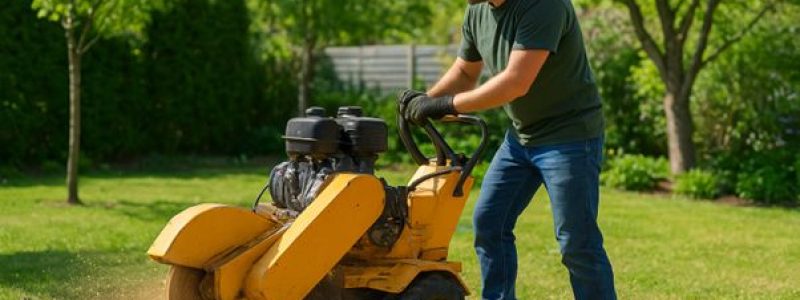When a tree is removed from your property, the trunk disappears, but the stump often remains. It may sit there, seemingly harmless and out of the way. However, leaving an old stump unattended can lead to a variety of problems over time. Many homeowners assume that an old stump simply decays and becomes part of the landscape. In reality, this is not always the case.
The Hidden Issues with Old Stumps
An old tree stump might appear innocuous, but it poses several risks. One of the most immediate concerns is safety. As the stump decays, its structure weakens, potentially becoming a tripping hazard in yards or public spaces. Children playing in the area or homeowners walking around may not notice it, especially in low light, leading to accidents.
Beyond safety, old stumps can attract pests. Termites, ants, and beetles are commonly drawn to the decaying wood. These pests do not always remain confined to the stump. In some cases, they may spread to nearby healthy trees or even into your home, causing structural damage over time. The presence of pests often goes unnoticed until significant damage has occurred.
How Old Stumps Affect Landscaping
Aesthetics is another consideration. An unsightly stump disrupts the visual appeal of a well-maintained garden or yard. Overgrown with weeds or moss, it detracts from the overall appearance. For homeowners investing in landscape beautification, an old stump stands out as an unwanted remnant.
In addition to appearance, an old stump occupies space that could otherwise be used more effectively. It limits planting options, restricts lawn area, and may obstruct pathways or garden designs. Even when left alone, the stump continues to occupy valuable land.
Why Natural Decay Isn’t Always the Answer
Some believe that simply waiting for the stump to decompose naturally is a viable solution. While it’s true that stumps break down over time, this process is slow and incomplete in many cases. Depending on the type of tree and environmental conditions, a stump can take several years—sometimes decades—to fully decompose.
Moreover, partial decay leaves the stump prone to regrowth. Certain tree species, such as maple or poplar, can sprout new shoots from the stump, resulting in unwanted vegetation that requires further maintenance. This regrowth creates a cycle of constant attention rather than a one-time solution.
The Role of Professional Stump Grinding Services
Professional stump grinding services provide a reliable solution. Unlike manual removal, which is labor-intensive and often leaves behind a bulky, uneven stump, grinding breaks down the stump to a manageable level below ground. Specialized equipment ensures precision and safety throughout the process.
Stump grinding reduces the stump to small wood chips, which can be left as mulch or removed according to the property owner’s preference. The process prevents regrowth by destroying the root collar and key growth points. It also eliminates the risk of pest infestation by removing the decaying wood.
Experts in stump grinding services understand the local soil conditions and the type of equipment best suited for the job. Their experience allows for efficient and thorough removal, minimizing disruption to the surrounding landscape.
Environmental Considerations
Removing an old stump helps maintain the health of nearby plants and trees. Decaying stumps can alter soil composition, introducing pathogens that affect other vegetation. Grinding the stump prevents the spread of disease and improves soil aeration, allowing for healthier plant growth.
In regions with dry climates, such as parts of Tucson, managing tree stumps properly is especially important. Stagnant wood can serve as tinder for wildfires. Professional stump removal reduces fire risk by eliminating dry, decomposing wood from the property.
Cost vs. Benefit Analysis
At first glance, DIY stump removal or leaving the stump untouched may seem economical. However, the long-term costs often outweigh the initial savings. Potential expenses include pest control treatments, repairs from structural damage caused by regrowth or falling limbs, and landscape redesign to accommodate the presence of the stump.
On the other hand, professional stump grinding services represent an investment in safety, aesthetics, and property value. The job is completed efficiently, with the assurance that it complies with local regulations and best practices. It also provides peace of mind, knowing the problem is resolved without future complications.
When Is the Right Time for Stump Grinding?
There’s no need to wait for the stump to begin causing visible problems. Proactive removal prevents future issues and enhances the appearance of your property. Whether you’ve recently removed a tree or are noticing signs of decay or regrowth, it is wise to consult professionals.
Many homeowners schedule stump grinding services as part of a broader landscape renovation or tree removal project. This approach ensures a cohesive plan that addresses current and future landscaping goals.
Wrapping Up the Stump Issue
An old stump may seem like a minor issue, but its presence can lead to safety hazards, pest infestations, and landscaping challenges. Relying on natural decay is neither practical nor effective, particularly in regions where climate and soil conditions slow decomposition.
Arbor Plus professional stump grinding services offer a thorough, efficient solution. By removing the stump and preventing regrowth, they safeguard your property from further damage and maintain its visual appeal. For homeowners in Tucson seeking a long-term solution, engaging experts ensures that the problem is resolved correctly and promptly.

